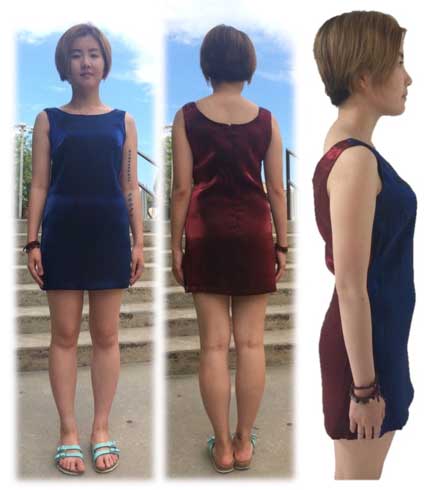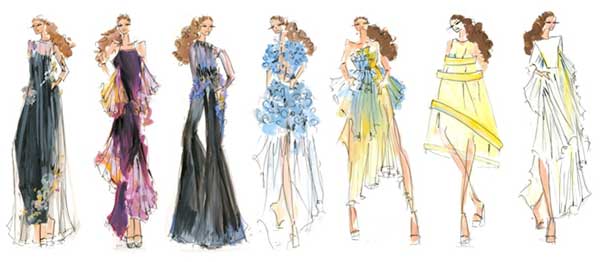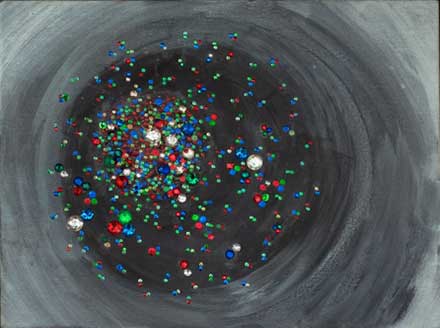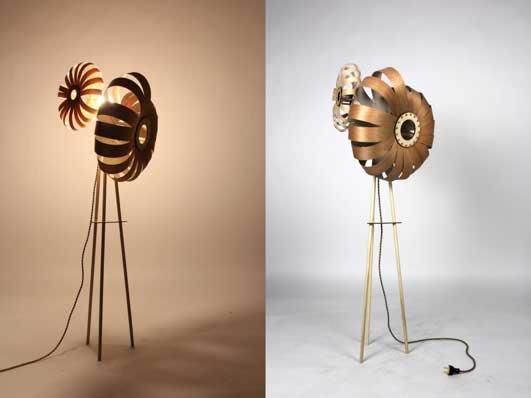Science as a Muse for Art and Design
Ágnes Mócsy
What benefits can scientists gain from engaging with the arts and artists? What benefits can artists get from engaging with science and scientists? What benefits can society gain from either of these? As a theoretical nuclear physicist who chose a career at an art and design school over a career exclusively focused on research, I have spent the past decade finding answers to these questions. As a professor teaching physics and astronomy at an art and design institute, I have relished the opportunity to be that matchmaker; a matchmaker for my own diverse interests beyond physics, and a matchmaker to make people fall in love with subjects they didn’t know they were inclined to fall in love with. Here I will present a selection of the works of my students who have used sculpture, painting, product design, graphic design, film, animated shorts, poetry, and fashion to communicate deeper aspects of science and to tell physics stories through the medium they are most comfortable with; pieces which can tell stories to wider audiences. I believe physics is accessible if we make it accessible. I believe we can bring science and our discoveries to life through designers and artists. I believe we can unveil a deeper connection between art and science. In doing that, we can reach people who otherwise would potentially be uninterested. Let me start with an art form that is probably least often associated with physics.
Physics and fashion don't often get mentioned in the same sentence. But fashion is more than just what to wear. It is a visual language. Just like music and literature, it is a form of expression and one that many feel passionate about. It is also an art form we all participate in. As such, it can have an impact, cause a stir, raise questions, start conversations, and reach across boundaries. Just like curiosity is one of our driving human traits, an internal force that eventually drove us to the process of evidence-based reasoning we call science, fashion is also a very fundamental form of expression intrinsic to who we are. So what can physics get from fashion and vice versa. Can we as physicists participate in the creation of fashion? Can we give fashion a new source of inspiration, can physics and science be the muse? Can we use this medium to tell a science story?
Here in NYC I see many wearing leggings made with the beautiful images taken by the Hubble Space Telescope. Can we do more than taking beautiful astronomy images and putting them on clothes? It is easy to put a beautiful image on a dress but does that tell us any more about astronomy than putting a picture of a flower on a t-shirt tells us about botany? Also not all of the inspiring and amazing aspects of science are so visual. The beauty is not always so easy to see. Like in the case of my own research on the earliest moments after the birth of our universe where we create a hot state of matter, the quark-gluon plasma, from which strong interactions carve out more familiar particles like protons and neutrons. Here I show examples of works that make the invisible visible and unveil a deeper connection between fashion and physics; at the same time exposing the scientific process to a wider audience.
To learn more about the author and her activities please visit www.agnesmocsy.com

The earrings depict the emissions spectra of Hydrogen and Helium, the two most abundant primordial elements in the universe. The emission spectra show the frequencies of electromagnetic radiation emitted by an atom transitioning from a higher energy state to a lower one. It’s the fingerprint of an element. The earrings were made with silver and inlays of color resin.

'SHIFT' DRESS by Ruby Gertz
In fashion a shift dress is a sleeveless dress that hangs loosely from the shoulders and does not cinch at the waist. This wearable astronomy "shift" dress plays with words by illustrating the blue-shift and red-shift of light; light from an object becomes bluer or redder depending on whether it’s approaching or receding. As the model walks away, the dress is redder and as the model approaches, the dress is bluer.

COSMOS CREATION COLLECTION by DalitzaBabilonia
This collection is inspired by the different stages of our Universe’s evolution, starting 13.82 billion years ago with the Big Bang, passing through the formation of hydrogen and helium, the dark ages, star formation and galaxy formation.

STELLAR FORMATION by Lauren Moseley
This evening wear collection depicts the stages of star formation. The looks from left to right represent the following stages: giant molecular cloud, emission nebulas, molecular cloud collapse, individuation of protostars, the beginning of thermonuclear fusion, the T-Tauri stage, and the main sequence.

QUARK-GLUON PLASMA ENTERING HADRONIZATION - FROM THE GLAMOROUS GLUONS SERIES by Sarah Szabo
This piece is part of a collection displayed at Brookhaven National Laboratory where one of the last atom smashers in the world collides atomic nuclei to study the behavior of quarks and gluons, the fundamental building blocks at the center of who we are, and quark gluon plasma, the matter that existed in the infant universe at one microsecond after the big bang. Canvas on panel, acrylic, oil, glitter, acrylic medium, decorative metal studs, minuscule rhinestones used to illustrate the collision of nuclei recreating the quark-gluon plasma, which is a soup of quarks and gluons condensing into composite particles, such as protons. Higher mass quarks are represented by larger sequins. They are created less frequently and often found in close proximity, in areas of higher energy density.

GALAXY BLOSSOM by Ji Hyun Chong
Using the Hubble Space Telescope, astronomers measured the motion of the Andromeda galaxy, the nearest galaxy to our Milky Way galaxy. Both galaxies contain supermassive black holes at their center surrounded by billions of stars making up spiral arms. Andromeda is approaching the Milky Way at a speed of 300 kilometers every second. In four billion years, Andromeda and the Milky Way will collide and the two spiral galaxies will merge to form a new elliptical galaxy. This project was inspired by a computer simulation of the collision showing that the two supermassive black holes will collide with each other accompanied by a flash of light. This stand lamp portrays the collision. The galaxies are represented by white oak and mahogany veneers mounted on cylindrical wooden center pieces. The center pieces represent the supermassive black holes while the strips of veneer represent the spiral arms. The Andromeda galaxy is made to resemble a Fibonacci spiral to reflect the way Andromeda appears to warp as it collides with the Milky Way.

INVISIBLE FORCES by Celeste Tsang
So many of the forces that govern the physical universe are invisible forces; unseen by the naked eye. This sculpture makes visible the invisible forces of gravity and magnetism through tension. The forces of gravity and magnetism are visually seen in one instance by magnetic repulsion, and in the tension of the threads that keep the magnets from achieving their desired positions. The one magnet’s seemingly gravity defying appearance means that, with the magnets’ close proximity with each other, the force of attraction between the two magnets is stronger than that of the gravitational force enacting on the magnet suspended in air, stronger than 9.8 m/s2. The metal filings serve as a way to visually think about the magnetic domains, the clusters of atoms that align according to their polarity, that exist in magnets and a piece of metal under the influence of a magnetic force.

WHAT IF YOU COULD FEEL THE SURFACE OF THE MOON AT YOUR DINNER TABLE? by Anjali Chandrashekar
Luna is a collection of ceramic lunar plates with a real representation of its surface and different phases. The project is aimed at creating a tactile and interactive dining experience by bringing some celestial/lunar understanding into homes. It also serves as a great piece for a dinner table conversation. This unique art+science intersection was brought to life using different methods. LIDAR is a remote sensing technology that measures distance by illuminating a target with a laser and analyzing the reflected light. With accurate LIDAR images, the surface was then height mapped to model the craters onto the plates, as is on the lunar surface. The mold was made possible by 3D printing of a model of the plate while maintaining accuracy and definition. The plates were then cast in ceramic to create a cross sensory experience while dining.
Ágnes Mócsy
amocsy@pratt.edu
These contributions have not been peer-refereed. They represent solely the view(s) of the author(s) and not necessarily the view of APS.
